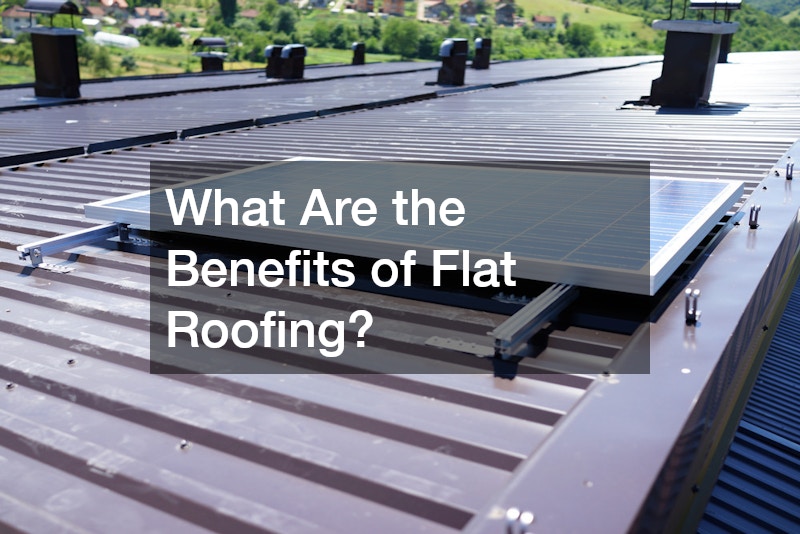Flat roofing has gained significant popularity in both residential and commercial construction due to its functional benefits, cost-effectiveness, and modern aesthetic appeal. Traditionally seen on commercial buildings, flat roofs have made their way into residential architecture, offering a range of advantages for property owners. Whether for a new construction or a roof replacement, flat roofing presents an array of benefits that make it a desirable option for many.
In this article, we will explore the advantages of flat roofing, including its cost savings, ease of maintenance, energy efficiency, and versatility.
1. Cost-Effective Solution
One of the most significant benefits of flat roofing is its affordability. When compared to sloped or pitched roofs, flat roofs are often less expensive to install. This is because the materials needed for construction are typically less costly, and the overall labor required is less intricate. The simplicity of a flat roof’s design leads to reduced construction time and lower labor costs, making it an economical choice for homeowners and commercial property owners alike.
Additionally, the flat roof’s straightforward design means that it requires fewer materials for installation. With no need for the framing and support structures that are required for pitched roofs, the overall cost of building a flat roof is significantly reduced. These savings can be used elsewhere in the project or reinvested into other areas of the building.
2. Easy Installation and Maintenance
Flat roofing is easier to install and maintain compared to other roofing systems. The lack of slopes and complicated angles makes the installation process faster and simpler. This can be especially important for commercial buildings that may need to minimize downtime during construction or renovations.
Furthermore, flat roofs are much easier to maintain. Since the surface is level, maintenance crews can easily access and inspect the roof for any signs of wear and tear. Tasks like clearing debris, performing repairs, and replacing sections of the roof are more straightforward and safer on a flat roof than on a sloped one.
With proper maintenance, a flat roof can last for many years. Inspections can be done quickly and at regular intervals, helping to spot problems early before they become costly repairs. Common maintenance issues, such as pooling water or small leaks, can also be handled more easily with flat roofing.
3. Maximizing Usable Space
One of the most attractive benefits of flat roofing is the additional usable space it provides. A flat roof creates a large, open surface area that can be used for various purposes. This extra space can be used for rooftop gardens, terraces, or outdoor living areas, which are becoming increasingly popular in urban environments where space is limited.
In addition to recreational use, flat roofs can be used to install solar panels, HVAC systems, and other equipment without taking up valuable interior space. Rooftop installations are ideal for flat roofs because the lack of slope means that there is ample room for mounting panels or systems securely. This is not only a functional benefit but can also be a sustainable choice, as solar panels can help reduce energy costs.
4. Improved Energy Efficiency
Flat roofs offer the potential for better energy efficiency, particularly in terms of insulation. A well-insulated flat roof can help regulate the internal temperature of a building, keeping it cooler in the summer and warmer in the winter. This can reduce the need for excessive heating and cooling, resulting in lower energy bills.
Flat roofs are also ideal for the application of reflective roofing materials. These materials are designed to reflect sunlight, keeping the building cooler and reducing the heat island effect in urban areas. By reflecting the sun’s rays instead of absorbing them, the building remains at a more comfortable temperature, which reduces the need for air conditioning during hot months.
Additionally, flat roofs provide an opportunity to install green roofing systems. These systems, which include vegetation and plants, act as natural insulators and absorb rainwater, reducing runoff and contributing to overall environmental sustainability.
5. Durability and Longevity
Flat roofs are known for their durability, especially when constructed with high-quality materials like EPDM (ethylene propylene diene monomer), TPO (thermoplastic olefin), or modified bitumen. These materials are designed to withstand various weather conditions, including heavy rain, wind, and even snow, making them suitable for a wide range of climates.
When installed correctly, flat roofs are capable of lasting for several decades. Many modern flat roofing systems are resistant to UV rays, which can degrade the materials on other types of roofs over time. Moreover, flat roofing materials are often designed to be flexible, allowing them to expand and contract with temperature fluctuations, reducing the likelihood of cracks or splits.
Watch the video above to learn more about flat roofing!
.

